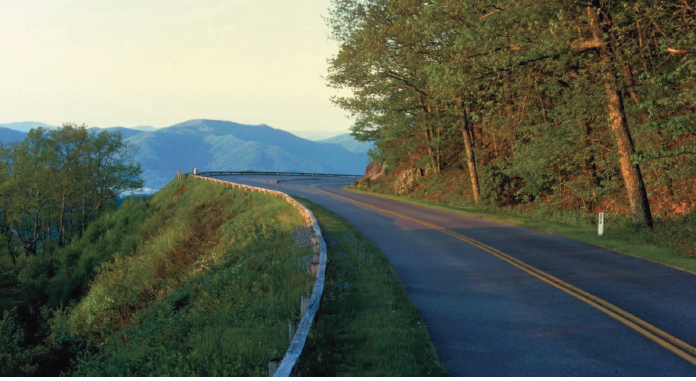S.W. and Rich Hermansen
Guest Writers
wine@lbknews.com
We drank a bottle of wine that we later discovered was a gift intended for another person,  Whoops, and we had no success finding the same wine at local stores. This pretext led us to the location of the seller of the misappropriated wine, a Limited Release Gewürztraminer from Biltmore Estate in Asheville, North Carolina.
Whoops, and we had no success finding the same wine at local stores. This pretext led us to the location of the seller of the misappropriated wine, a Limited Release Gewürztraminer from Biltmore Estate in Asheville, North Carolina.
A tropical storm meandering around the Gulf of Mexico prompted us to make a field trip to the Blue Ridge area of Appalachia, a mountainous area extending from south of Birmingham, Alabama to north of Pittsburgh, Pennsylvania, and west of Atlanta, Georgia and Harrisburg, Pennsylvania and east of Nashville, Tennessee and Cleveland, Ohio.
From south to north, Appalachia has a similar terrain: rolling hills and mountains covered with hardwood trees and long river valleys with crops and pastures carved into somewhat level spaces near river beds carved out by glaciers and floods. The 206,000 square miles in Appalachia has 2.63 million inhabitants or 128 persons on average per square mile. Massachusetts has seven times the population density of Appalachia. During the hot summer months, the mountains have the cool evening temperatures and invigorating air quality that appeal to tourists. The popular Blue Ridge Parkway follows high ridges for 469 miles from the Great Smokies National Park in Tennessee to the Shenandoah National Park in Virginia. Parkway observation points offer panoramic views of the hills and valleys below the ridges.
Below the ridges, country roads twist and wind through gaps between small wooded mountains reminiscent of the Sierra Foothills or Mendocino wine regions of California. A few wineries have tapped into the potential for wine tourism, but for the main part the area around Asheville lacks some of the features of wine regions in Oregon, Virginia, Texas, or, for that matter, Eastern North Carolina. The absence of signage on roadways pointing to wineries, combined with the the tendency to show only the names of cross streets on street signs, makes it doubly difficult to locate them. Navigation programs often fail to connect to the internet in dead zones within Appalachia. Further, the towns do not have much of an identity other than that provided by churches of various denominations and farm supply stores. Rarely does a sign mark the beginning of a town and another its end. A town may be nothing more than a wide space on a road.
The one common theme in Appalachian wine tourism has to be the lure of music. Wineries host weekend appearances of local and touring bands. Radio spots playing between the constant clinking of banjo, mandolin, and guitar rhythms and twangy nasal vocals of Bluegrass, Blue Ridge Rock, and Nashville Country & Western direct fans to obscure locations in the heartland of Appalachia.
Circling back to the Biltmore Gewürztraminer, we learned how Biltmore and other wineries augment their wine portfolios. Biltmore imports the Gewürztraminer from California and puts its own label on the bottle. This practice actually does have a sensible purpose, in that it gives wine buyers a choice of a better version of a wine than that the Biltmore could grow on its estate. In truth, the Gewürztraminer in its niche of off-dry white wines rated in our tasting better than the passable but bland Biltmore estate-grown Chardonnay or Sauvignon Blanc,
Emergence of Appalachia as a wine tourist destinations will depend on how well wineries in the region provide, either by growing locally or importing, wines that appeal to tourists and wines that attract tourists. We’ll have more to say about wines that appeal to tourists. The local Chardonnay and Avignon Blanc that we have tasted will appeal to people who are looking to kick back and enjoy a smooth wine and country road music.
Over time we hope to see Appalachia vineyards produce grapes amenable to the local climate and soil, as has happened in Virginia with French Viognier, indigenous Norton, and French Cabernet Franc, in New York State with German Riesling and ice wines, and in Texas with Spanish Tempranillo and Albariño. Each emerging wine region has to discover its signature wines, Appalachia is entering the process of doing that. This wine region has great potential and will likely find a good way forward.
S.W. Hermansen has used his expertise in econometrics, data science and epidemiology to help develop research databases for the Pentagon, the National Institutes of Health, the Department of Agriculture, and Health Resources and Services. He has visited premier vineyards and taste wines from major appellations in California, Oregon, New York State, and internationally from Tuscany and the Piedmont in Italy, the Ribera del Duero in Spain, the Barossa Valley and McLaren Vale in Australia, and the Otego Valley in New Zealand. Currently he splits time between residences in Chevy Chase, Maryland and St. Armand’s Circle in Florida.
Rich Hermansen selected has first wine list for a restaurant shortly after graduating from college with a degree in Mathematics. He has extensive service and management experience in the food and wine industry. Family and friends rate him as their favorite chef, bartender, and wine steward. He lives in Severna Park, Maryland.

